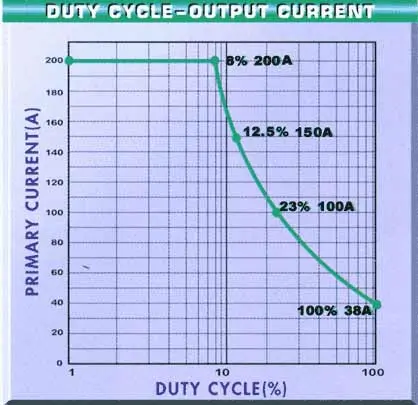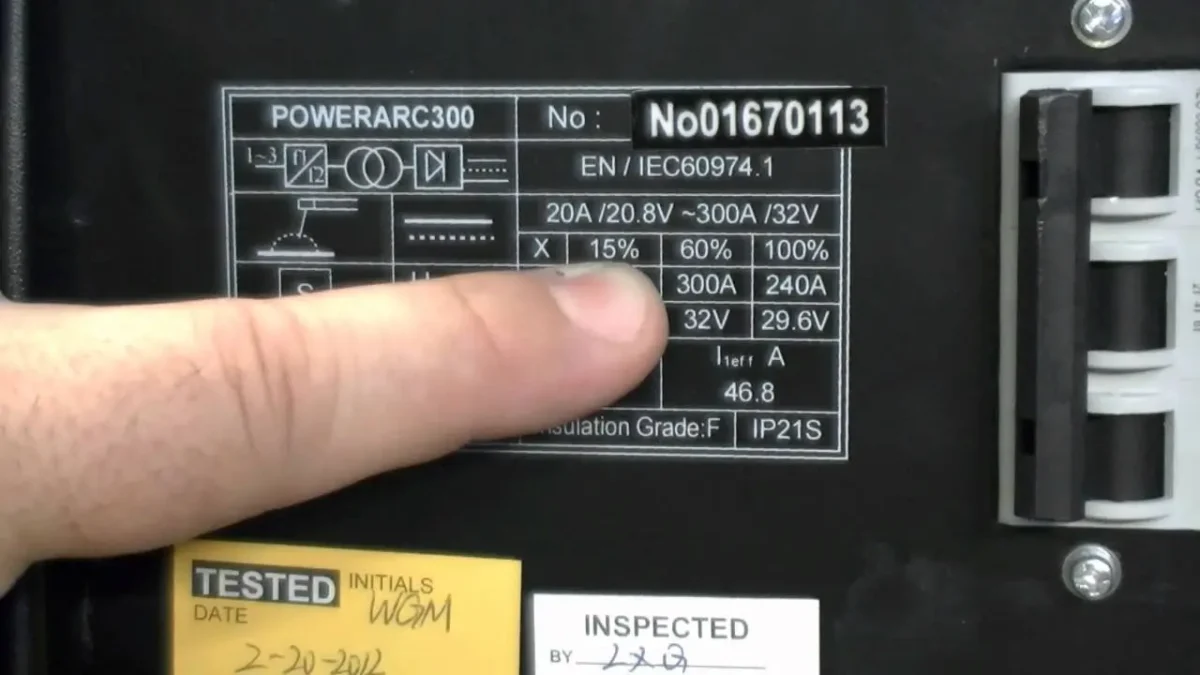A welding machine’s duty cycle refers to the percentage of time it can operate continuously within a 10-minute period without overheating. For example, a 60% duty cycle means the welder can run for 6 minutes and requires a 4-minute cooling period, while a 100% duty cycle allows continuous operation.
When you’re getting started with welding, you have a lot to learn about the intricacies of your welding machine. Besides learning how to set up your welding machine, you must also learn how to use your welding machine without damaging your equipment or endangering yourself. One important thing that can help you know how to weld safely is understanding the welding machine’s duty cycle.
A duty cycle describes the percentage of time within a specified duration that a welding machine can draw current before it overheats.
For example, a welding machine with a 50% duty cycle at 200 amps for 10 minutes, means that it can draw 200 amps for 5 minutes before it needs to cool down.
Understanding the duty cycle will help you get the most out of your welding machine. Here is what you need to know about this welding term.
Table of Contents
Why Is the Duty Cycle Important?
The duty cycle will change depending on the amperage of the welding machine you are using. This makes sense because the higher the amperage, the hotter your machine will get, bringing it closer to overheating. If you run your welding machine at a lower amperage, you can use it longer.
You might be wondering what happens when you exceed the duty cycle. Most modern welding machines have built-in protection because they know welders will forget this calculation. The thermal overload protection senses when the internal components of a machine approach a high internal temperature. Then, it automatically turns the machine off to prevent damage.
If you don’t want your welding machine to turn off randomly while working, keep the duty cycle in mind and give your machine enough rest before turning it back on again.
What Is a Common Duty Cycle?
Duty cycles differ depending on the amperage and the type of welding machine you are working with. Your instruction manual and label will have the duty cycle.
The cycle is expressed as amperage and percentage. You’ll probably see a series of numbers that look like this:
- 200A @ 60%
- 175A @ 70%
- 150A @ 80%
The first number refers to the amps you run with the welding machine. The second number refers to the percentage of time that a welding machine can be active at that amperage. The percentage refers to a 10-minute interval, so 60% of ten minutes is six minutes.

This table shows my recommendations for welding machine duty cycle based on some common scenarios:
| Welding Scenario | Recommended Duty Cycle |
|---|---|
| Light Fabrication Work (Home Use) | 20% – 40% |
| Automotive Work (Garage Use) | 20% – 60% |
| Heavy Fabrication Work (Professional Use) | 60% – 85% |
| Industrial Applications | 85% – 100% |
| MIG Welding (Production Line) | 60% – 100% |
| TIG Welding (Detailed Work) | 20% – 50% |
| TIG Welding (Pipe Joint Welding) | 60% – 100% |
| Stick Welding (General) | 20% – 40% |
| Stick Welding (Heavy-Duty Applications) | 60% – 85% |
I have also put together a table of the most popular welding machines and their duty cycles so you can see some real world examples:
| Welding Machine | Duty Cycle |
|---|---|
| Miller Millermatic 211 MIG Welder | 40% @ 150A |
| Hobart Handler 140 MIG Welder | 20% @ 90A |
| Lincoln Electric Power MIG 210 MP | 40% @ 100A |
| Forney Easy Weld 140 MP | 30% @ 90A |
| Miller Dynasty 210 TIG Welder | 60% @ 210A |
| Hobart Stickmate 160i Stick Welder | 30% @ 130A |
| Lincoln Electric Square Wave TIG 200 | 25% @ 200A |
| Esab Rebel EMP 215ic MIG/TIG/Stick Welder | 40% @ 205A |
| Everlast PowerTIG 185 TIG Welder | 35% @ 185A |
| Amico Power DC-160A Stick Welder | 60% @ 160A |
What Duty Cycle Do You Need as a Beginner?
When thinking about which welding machine to get or which amperage to set your machine, you now know that you have to think about the duty cycle. However, how will you know which cycle is best for your machine?
The duty cycle is not so important when deciding which welding machine is better than another. This is more of a safety indicator than an indicator of quality or easy usage unless you are a MIG welder (more on that later).
So there is no duty cycle that is better than another when setting up your welding machine as a beginner. What matters is that you are aware of this duty cycle and are careful not to take your machine too close to the edge; otherwise, it can cut out on you.
Information about a duty cycle can help you determine whether a welding machine is a quality product. You can look at:
- A machine’s efficiency – Some machines have a low-duty cycle because they only have a 240V input.
- The input type
- Manufacturing quality – Producers should offer information about their duty cycle tested against a standard such as the European Standard.
Duty Cycle for welding processes
How closely you need to pay attention to your duty cycle will also depend on the type of welding you are doing.

MIG Welding
The duty cycle is the most important for MIG welders. MIG welding is a mostly automated process where the filler metal enters the fold automatically. This lessens the impact on the welding machine, which can work longer than machines engaging in other types of welding. MIG welders are prepared to weld continuously for longer because less coordination is involved.
In production, where everything is designed for maximum efficiency and welders need to spend as much time running their machines, the duty cycle is essential. Producers will buy welding machines with as long a duty cycle as possible to avoid unnecessary shutdowns while waiting for the machine to cool down.
Stick Welding
Stick welding (or MMA) is more complex than MIG welding. Welders have to manually switch out electrodes, adjust tools, chip away slag, and do all sorts of things that help the welding process run more smoothly. No matter the duty cycle, stick welders spend most of their time with their welding machine turned off as they manually adjust everything else.
Duty cycles can be below 30% for stick welders without affecting the welding process.
TIG Welding
The answer for TIG welding is more complicated. The problem is that this welding process has a lot of applications. TIG welding for detailed work involves a lot of downtime and doesn’t need a high duty cycle.
However, some TIG welding applications, such as pipe joint welding, need a high duty cycle; otherwise, there will be an awkward break in the middle of the joint.
Final Thoughts
The duty cycle of your welding machine tells you how much you can use it continuously within a 10-minute period without it overheating and turning off. Duty cycles vary considerably depending on input, machine efficiency, and amperage. If you’re doing MIG welding and some types of TIG welding, duty cycle can be very important.
